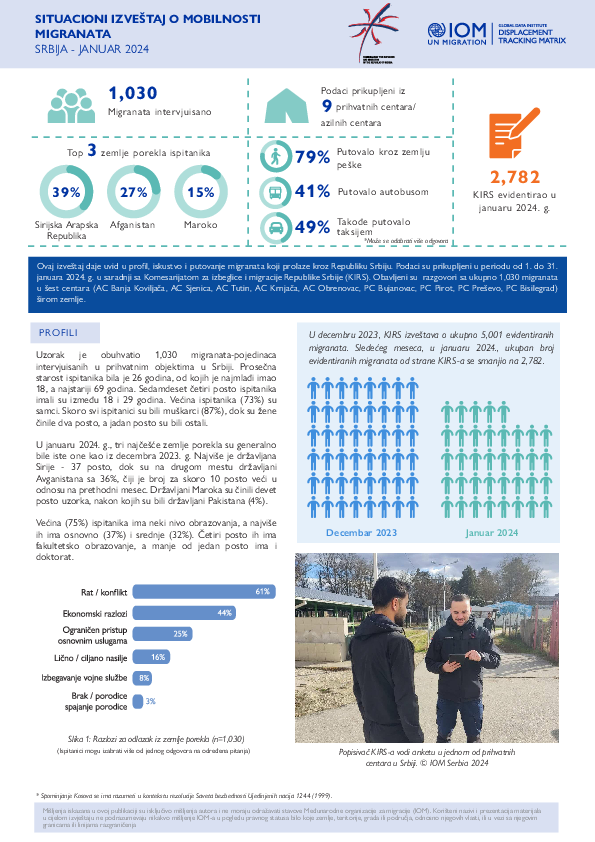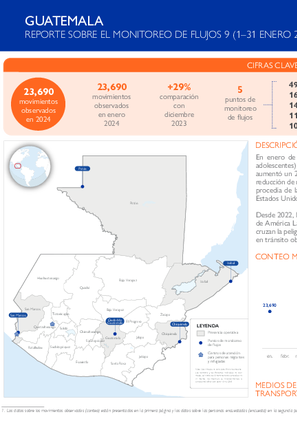-
Countries
-
Data and Analysis
-
Special Focus
-
Crisis Responses

Contact
DTM Europe, DTMMediterranean@iom.int
Language
English
Location
Serbia
Period Covered
Jan 01 2024
Jan 31 2024
Activity
- Survey
- Flow Monitoring
This report provides insights into the profiles, experiences and journeys of migrants transiting through the Republic of Serbia. Data was collected from 1 to 31 January 2024 together with the Commissariat for Refugees and Migrants of the Republic of Serbia (SCRM). Total of 1030 migrants were interviewed in six centres (Asylum Centre (AC) Banja Koviljaca, AC Sjenica, AC Tutin, AC Krnjaca, AC Obrenovac, Reception Centre (RC) Bujanovac, RC Pirot, RC Presevo, RC Bosilegrad) across the country.

Contact
DTM Europe, DTMMediterranean@iom.int
Language
Bosnian, Croatian, Serbian
Location
Serbia
Period Covered
Jan 01 2024
Jan 31 2024
Activity
- Survey
- Flow Monitoring
Ovaj izveštaj daje uvid u profil, iskustvo i putovanje migranata koji prolaze kroz Republiku Srbiju. Podaci su prikupljeni u periodu od 1. do 31. januara 2024. g. u saradnji sa Komesarijatom za izbeglice i migracije Republike Srbije (KIRS). Obavljeni su razgovori sa ukupno 1,030 migranata u šest centara (CA Banja Koviljača, CA Sjenica, CA Tutin, CA Krnjača, CA Obrenovac, PC Bujanovac, PC Pirot, PC Preševo, PC Bisilegrad) širom zemlje.

Contact
DTM Europe, DTMMediterranean@iom.int
Language
Bosnian, Croatian, Serbian
Location
Bosnia & Herzegovina
Period Covered
Jan 01 2024
Jan 31 2024
Activity
- Survey
- Flow Monitoring
Ovaj izvještaj daje uvid u profile, iskustva, potrebe i rute koje koriste, kao i namjere migranata koji se kreću kroz Bosnu i Hercegovinu (BiH)1. Podaci su prikupljani od 3. januara do 31. januara 2024. g. IOM je u cilju praćenja trendova u ulascima i izlascima, kao i modalitetima tranzita unutar BiH vršio osmatranje rute u Republici Srpskoj, Kantonu Sarajevo, Posavskom Kantonu, Tuzlanskom Kantonu, Bosansko-podrinjskom Kantonu, i Unsko-sanskom Kantonu. Osim toga, IOM je anketirao 872 migranta na lokacijama aktivnog tranzita, kao što su autobusne stanice, ili na najvažnijim lokacijama ulaska i izlaska širom zemlje, kao i u četiri privremena prihvatna centra (PPC) u BiH (Lipa, Ušivak, Borići i Blažuj).

Contact
DTM Europe, DTMMediterranean@iom.int
Language
English
Location
Bosnia & Herzegovina
Period Covered
Jan 01 2024
Jan 31 2024
Activity
- Survey
- Flow Monitoring
This report provides insights into the profiles, experiences, needs, routes travelled and intentions of migrants transiting through Bosnia and Herzegovina (BiH).1 Data was collected from 3 January to 31 January 2024. IOM carried out a route observation exercise in the Republika Srpska, Sarajevo Canton, Posavina Canton, Tuzla Canton, Bosnian-Podrinje Canton and Una Sana Canton to monitor trends in entries and exits as well as transit modalities within BiH. IOM also surveyed 872 migrants in active transit locations such as bus stops or at key entry and exit locations throughout the country as well as in four transit reception centres (TRCs) in BiH (Lipa, Ušivak, Borići and Blažuj).

Contact
iomguatemala@iom.int
Language
English
Location
Guatemala
Period Covered
Jan 01 2024
Jan 31 2024
Activity
- Flow Monitoring
In January 2024, 23,690 movements were observed in Guatemala (16% children) and 564 individuals were surveyed.1 The number of observed movements increased by 29 per cent from December 2023 (18,390) due to the usual declining trend in movements around end-of-year festivities. More than half of movements originated from the Bolivarian Republic of Venezuela (53%). The main intended destination was the Unites States of America (87%).
Since 2022, migratory flows through the Latin America and Caribbean region have increased significantly, with record levels of persons crossing the perilous jungle of the Darién National Park from Colombia into Panama. The in-transit flows tracked in Guatemala have mirrored these regional migration trends.

Contact
iomguatemala@iom.int
Language
English
Location
Guatemala
Period Covered
Jan 01 2024
Jan 31 2024
Activity
- Flow Monitoring
En enero de 2024 se observaron 23,690 movimientos en Guatemala (16% niños, niñas y adolescentes) y 564 personas fueron encuestadas.1 El número de movimientos observados aumentó un 29 por ciento desde diciembre de 2023 (18,390) debido a la tendencia habitual de reducción de movimientos por las festividades de fin de año. Más de la mitad de los movimientos procedía de la República Bolivariana de Venezuela (53%). El principal destino previsto fue los Estados Unidos de América (87%).
Desde 2022, los flujos de migrantes en tránsito se incrementaron significativamente en la región de América Latina y el Caribe, observando cantidades nunca antes registradas de personas que cruzan la peligrosa selva del Parque Nacional del Darién desde Colombia hacia Panamá. Los flujos en tránsito observados en Guatemala han reflejado dichas tendencias migratorias regionales.

Contact
dtmlebanon@iom.int
Language
English
Location
Lebanon
Period Covered
Oct 10 2023
Feb 20 2024
Activity
- Mobility Tracking
- Baseline Assessment
Since October 8 there has been an increase in cross-border incidents between Israel and Lebanon, resulting in the displacement of people both within the South and elsewhere within the country. Since October 10, the Displacement Tracking Matrix (DTM) has been conducting the daily monitoring of population movements. The objective of the exercise is to inform preparedness and response planning.

Contact
DTM South Sudan, SouthSudanDTM@iom.int
Language
English
Location
South Sudan
Period Covered
Jun 19 2023
Jul 19 2023
Activity
- Survey
- Return Intention
This study provides a comprehensive assessment of the multiple dimensions of fragility in South Sudan at the subnational level: political and legal, social, economic, security, and environmental. By providing evidence-based contextualized insights, the study seeks to guide the development of programming and policies to support peacebuilding efforts in South Sudan, in in alignment with the Humanitarian Development Peace Nexus (HDPN) approach. South Sudan is an important case for the study of fragility because the country is in the process of transitioning from a humanitarian-only response plan to a more recovery-focused approach in which fragility, rather than armed conflict, is the primary barrier to sustainable peace and development.
The study deepens the understanding of how fragility varies across these dimensions within four distinct South Sudanese counties (Yei, Kajo-Keji, Bor, and Wau). It explores the impact of this variation on the local contexts where peacebuilding interventions are carried out by IOM and partners. To address these objectives, the research was conducted through a face-to-face household survey involving 1,595 adult respondents (51 per cent female, 49 per cent male), with approximately 400 participants in each of the four selected counties.
The findings reveal a complex landscape across multiple fragility dimensions. On the political dimension, there is a notable lack of confidence in government authorities at local, state, and national levels, and concerns persist about expressing political opinions in the context of national elections. However, there is a positive trend towards greater acceptance of women in politics. In the security dimension, perceptions vary across counties, with overall low trust in security actors and a reliance on informal mechanisms for dispute resolution. Informal armed groups continue to be seen as a source of insecurity, and concerns about renewed conflict linger. Opinions on transitional justice, accountability, and reconciliation are divided. In the social dimension, feelings of community acceptance are generally high, regardless of displacement status, although these results should be interpreted cautiously in light of potential social desirability bias on sensitive questions. Gender-based violence (GBV) including child marriage remains a challenging issue. Around 23 per cent of respondents had experienced Housing, Land, and Property (HLP) disputes, which are typically resolved by village chiefs, and acceptance of women’s land ownership was mixed. Lack of documentation of legal ownership and conflicts over natural resources including cattle and water are significant risk factors for HLP disputes. The majority of respondents rely on subsistence farming for their livelihood, and have limited purchasing power. Many also report an increase in the number and frequency of natural hazards contributing to environmental fragility.
The analysis shows important differences between the four counties across different dimensions of fragility. Bor stands out as the county with the highest levels of security, environmental, and economic fragility. Kajo-Keji, on the other hand, exhibits the highest level of political fragility, alongside high scores in economic and environmental fragility. Yei County records the highest level of social fragility and moderate levels of political and security fragility. In contrast, Wau County displays moderate overall fragility levels, with the lowest political fragility scores, along with low levels of social, economic and environmental fragility. Although the baseline pilot study does not enable precise identification of the drivers of subnational variation in fragility, we suggest potential explanations based on local context that could be more rigorously tested with follow-on studies.
OBJECTIVES
This study aims to assess multiple dimensions of fragility in South Sudan at the subnational level in order to inform evidence-based and locally contextualized peacebuilding programmatic interventions in line with the HDPN approach.
Specifically, the study is designed to advance the following objectives:
- Improved understanding of how variation in fragility across five dimensions (political and legal, social, economic, security, and environmental) in four different counties affects the local contexts where IOM and partners implement peacebuilding interventions;
- Inform evidence-based and context-specific programming and policies within the HDPN approach;
- Identify remaining knowledge gaps and open questions in need of further research including the effects of different types of fragility on efforts to promote sustainable development and peace.
Understanding variation in fragility across different regions within the country is crucial for developing context-specific interventions in line with the HDPN approach. This pilot study is the first empirical analysis of subnational variation in fragility in South Sudan across five different dimensions: political and legal, economic, social, security, and environmental. The results provide detailed insights into the needs of the four counties studied, which have broader implications for IOM programming in South Sudan.

Contact
DTM South Sudan, SouthSudanDTM@iom.int
Language
English
Location
South Sudan
Period Covered
Aug 31 2021
Oct 14 2021
Activity
- Survey
- Return Intention
1. This report provides field-level data to complement and validate findings from the 2020 Flood Damage and Needs Assessment (FDNA) on the 2020 seasonal floods (June-December) in South Sudan which largely relied on the analysis of remote sensing and geodata. The World Bank tasked IOM to conduct field assessments in three payams (administrative level 3) to collect empirical data from flood-affected areas to verify and substantiate findings from the FDNA.
2. The FDNA Field Validation combines four sources of primary data: two quantitative tools mapping the flood impact and exploring community responses of which one was conducted at the boma level (administrative level 4) and one at a more granular level (facility, livelihood area and settlement level), as well as two qualitative tools of which one is a set of Focus Group Discussions (FGDs) at the boma level and the other is a series of Key Informant Interviews (KIIs) with participants recruited from key stakeholder groups at the national level. IOM interviewed and consulted more than 1,131 individuals for the exercise across all tools.
3. This report provides insights on multiple levels of granularity concerning the 2020 floods in terms of the extent and severity of impact on public infrastructure, shelter, displacement, livelihoods, Health, Water, Hygiene and Sanitation (WASH), and education.
● In terms of infrastructure, findings confirm and illustrate the floods’ debilitating impact on public buildings, roads and livelihood institutions. Some 21 per cent of 709 accessed facilities were found to be dysfunctional. Half of all remaining functional facilities were affected by the floods in 2020. Diminished road access was observed across sectors as communities were unable to access important locations such as healthcare, markets, and educational facilities. Access constraints not only limited movement out of flooded areas, but also prevented aid from reaching populations in need. Impacts on damaged facilities were not only severe (more than 50% reported medium to severe damage) but also protracted (more than 80% of damage facilities were still affected between one and six months later).
● For a population largely dependent on the land, the floods made most forms of livelihood activities impossible. Farmers reported being unable to harvest anything in half of the accessed bomas where farming is practiced. Waterlogged fields meant that farming was rendered impossible long after the rains had stopped, and a lack of harvest made planting in the subsequent season impossible. The analysis also indicates that tensions arose between farmers and cattle keepers, and also among various cattle keeping groups, as a result of flooding on usable land. Communities reported losing a large number of cattle which often drowned or succumbed to diseases that spread after the floods subsided.
● The 2020 floods caused displacement within 11, from 9 and to 9 out of 16 assessed boma. Movements remained localized in most cases, with exceptions in Bor, where population movement was more common across county and state lines. Communities quickly switched from being hosts communities to being hosted by other communities as IDPs, while many struggled to support arriving IDPs because of the additional stress the floods had put on available resources. IOM found that recurrence of flooding and longevity of stagnant water has changed the patterns and temporality of displacement, which after the 2020 flood was often long-term with periods of displacement lasting up to the time of assessment (September 2021) in half of the assessed boma.
● Shelter damage was severe and widespread in all assessed boma. On a settlement level, the FIFIS tool revealed that, with few exceptions, the floods damaged shelters in almost all assessed areas (97% or 63 of 65 flooded settlements). Floods moreover hindered access to common shelter building materials, preventing the rehabilitation of homes. In the majority of settlements, shelters had not been repaired in any way and remained largely inhabitable (56% or 35/63).
● Respondents reported an increase in disease outbreaks, notably malaria upsurges, and a simultaneous decrease in access to healthcare.
Access to education was similarly stressed, most commonly due impassible roads but also damaged educational facilities.
4. This report also explores community-based disaster risk management (CBDRM) in South Sudan, with a focus on identifying current capacities at the local level, and gaps that stakeholders can address through strategic support and programming. In line with South Sudan’s nascent National Disaster Risk Management Policy, and the recurrence of devastating floods and the heightened vulnerability of communities to climate-related shocks, , government, humanitarians and development partners are seeking to strengthen disaster preparedness and response across the country, including at the community level. The analysis shows a range of ad hoc CBDRM initiatives, primarily through the form of mobilization to build dykes using local materials, the establishment of disaster risk management committees, and mobilization to safe areas. Additionally, while women and youth often bear tremendous responsibility in flood-affected communities, including caring for vulnerable household members, as well as building and maintaining dykes, they continue to be marginalized in local decision-making. Local and indigenous knowledge is often used as one mechanism for communities to anticipate and prepare for floods, however this knowledge has not been integrated into early warning systems and formal coordination mechanisms developed by partners and government institutions. Key gaps were identified in terms of coordination amongst partners and government stakeholders, as CBDRM mechanisms continue to operate at an ad hoc level. Lastly, compounding factors have made it challenging for stakeholders to support CBDRM initiatives, particularly in relation to inter-communal violence and displacement.

Contact
DTM Libya, DTMLibya@iom.int
Language
English
Location
Libya
Period Covered
Oct 01 2023
Dec 31 2023
Activity
- Flow Monitoring
- Mobility Tracking
- Baseline Assessment
This infographic presents the key findings of Round 50 of the mobility tracking and flow monitoring components of the Displacement Tracking Matrix (DTM) programme in Libya.
